�
Note:
This is a shared user manual for ONETOUCH 6037I/ONETOUCH 6037B.
Table of Contents
3
Safety and use ............................................................................4
General information ...............................................................12
1 Your mobile .......................................................................14
1.1 Keys and connectors ................................................................................14
1.2 Getting started ..........................................................................................17
1.3 Home screen ..............................................................................................20
2 Text input ...........................................................................31
2.1 Using Onscreen Keyboard ......................................................................31
2.2 Text editing .................................................................................................32
Phone call, Call log and Contacts ....................................34
3.1
Phone ...........................................................................................................34
3.2 Call log .........................................................................................................42
3.3
People ..........................................................................................................43
Messaging, Email ...............................................................51
4.1 Messaging ....................................................................................................51
4.2 Gmail/Email .................................................................................................58
4.3 Hangouts .....................................................................................................65
Calendar & Time .................................................................68
5.1 Calendar ......................................................................................................68
5.2 Time .............................................................................................................70
6 Getting connected ............................................................72
6.1 Connecting to the Internet ....................................................................72
6.2
Browser .......................................................................................................75
4
5
6.3 Connecting to Bluetooth devices ........................................................83
6.4 Connecting to a computer .....................................................................85
6.5
Sharing your phone's mobile data connection ...................................86
6.6 Connecting to virtual private networks ..............................................87
6.7 Configuring Internet (SIP) calling ...........................................................89
7 Google Play Store ............................................................91
7.1
Locate the item you want to download and install ..........................91
7.2 Download and install ................................................................................92
7.3 Manage your downloads ..........................................................................94
8 Multimedia applications ...................................................96
8.1 Camera ........................................................................................................96
8.2 Gallery .........................................................................................................99
8.3 YouTube .....................................................................................................101
8.4 Music ..........................................................................................................102
8.5 Video Player ..............................................................................................104
9 Google Maps ....................................................................105
9.1 Get My Location .....................................................................................105
Search for a location ..............................................................................106
9.2
9.3
Star a location ..........................................................................................107
9.4 Get driving, public transportation or walking directions...............108
9.5 Arrangement of Layers ..........................................................................109
10 Others ..............................................................................110
10.1 Calculator ..................................................................................................110
10.2 File Manager .............................................................................................111
10.3 Sound Recorder ......................................................................................112
10.4 Radio ..........................................................................................................112
10.5 Setup Wizard ...........................................................................................114
10.6 Alcatel Help .............................................................................................114
10.7 Other applications .................................................................................114
1
2
11 Settings ............................................................................115
11.1 Wireless & networks .............................................................................115
11.2 Device ........................................................................................................117
11.3 Personal .....................................................................................................120
11.4 Accounts ...................................................................................................127
11.5 System ........................................................................................................127
12 Making the most of your phone ....................................135
12.1 ONETOUCH Center .............................................................................135
12.2 Upgrade .....................................................................................................136
13 Telephone warranty ........................................................138
14 Accessories .....................................................................140
15 Troubleshooting ..............................................................141
16 Specifications ...................................................................146
This product meets applicable national SAR limits of
2.0W/kg. The specific maximum SAR values can be
found on page 8 of this user guide.
When carrying the product or using it while worn
on your body, either use an approved accessory such
as a holster or otherwise maintain a distance of 10
mm from the body to ensure compliance with RF
exposure requirements. Note that the product may be
transmitting even if you are not making a phone call.
www.sar-tick.com
Safety and use ..............................
We recommend that you read this chapter carefully before using your
mobile phone. The manufacturer disclaims any liability for damage, which
may result as a consequence of improper use or use contrary to the
instructions contained herein.
• TRAFFIC SAFETY:
Given that studies show that using a mobile phone while driving a vehicle constitutes
a real risk, even when the hands-free kit is used (car kit, headset...), drivers are
requested to refrain from using their mobile phone when the vehicle is not parked.
Check the laws and regulations on the use of wireless mobile phones and their
accessories in the areas where you drive. Always obey them. The use of these devices
may be prohibited or restricted in certain areas.
When driving, do not use your mobile phone and headphone to listen to
music or to the radio. Using a headphone can be dangerous and forbidden
in some areas.
When switched on, your mobile phone emits electromagnetic waves that
can interfere with the vehicle’s electronic systems such as ABS anti-lock
brakes or airbags. To ensure that there is no problem:
-do not place your mobile phone on top of the dashboard or within an
airbag deployment area,
-check with your car dealer or the car manufacturer to make sure that
the car’s electronic devices are shielded from mobile phone RF energy.
• CONDITIONS OF USE:
You are advised to switch off the mobile phone from time to time to
optimize its performance.
Remember to abide by local authority rules of mobile phone use on
aircrafts.
Operational Warnings: Obey all posted signs when using mobile devices
in public areas.
3
4
�
Follow Instructions to Avoid Interference Problems: Turn off your mobile
device in any location where posted notices instruct you to do so. In an
aircraft, turn off your mobile device whenever instructed to do so by airline
staff. If your mobile device offers an airplane mode or similar feature,
consult airline staff about using it in flight.
Do not allow your mobile phone to be exposed to adverse weather or
environmental conditions (moisture, humidity, rain, infiltration of liquids,
dust, sea air, etc.). The manufacturer’s recommended operating temperature
range is -10°C (14°F) to +55°C (131°F) (the max value depends on device,
materials and housing paint/texture).
Switch the mobile phone off when you are in health care facilities, except
in designated areas. As with many other types of equipment now in regular
use, mobile phones can interfere with other electrical or electronic
devices, or equipment using radio frequency.
Switch the mobile phone off when you are near gas or flammable liquids.
Strictly obey all signs and instructions posted in a fuel depot, gas station, or
chemical plant, or in any potentially explosive atmosphere.
When the mobile phone is switched on, it should be kept at least 15 cm
from any medical device such as a pacemaker, a hearing aid or insulin pump.
In particular when using the mobile phone you should hold it against the
ear on the opposite side to the device, if any.
Read and follow the directions from the manufacturer of your implantable
medical device. If you have any questions about using your mobile device
with your implantable medical device, consult your healthcare provider.
To avoid hearing impairment, answer the call before holding your mobile
phone to your ear. Also move the handset away from your ear while using
the “hands-free” option because the amplified volume might cause hearing
damage.
It is recommended to have proper supervision while small children use
your mobile phone.
When replacing the cover please note that your mobile phone may contain
substances that could create an allergic reaction.
Always handle your mobile phone with care and keep it in a clean and
dust-free place.
Over 55°C (131°F) the legibility of the mobile phone’s display may be
impaired, though this is temporary and not serious.
Do not open or attempt to repair your mobile phone yourself.
Do not drop, throw or try to bend your mobile phone.
Do not use the mobile phone if the glass made screen, is damaged, cracked
or broken to avoid any injury.
Do not paint it.
Use only batteries, battery chargers, and accessories which are
recommended by TCT Mobile Limited and its affiliates and are compatible
with your mobile phone model.TCT Mobile Limited and its affiliates
disclaim any liability for damage caused by the use of other chargers or
batteries.
Your mobile phone should not be disposed of in a municipal waste. Please
check local regulations for disposal of electronic products.
Remember to make back-up copies or keep a written record of all
important information stored in your mobile phone.
Some people may suffer epileptic seizures or blackouts when exposed to
flashing lights, or when playing video games. These seizures or blackouts
may occur even if a person never had a previous seizure or blackout. If you
have experienced seizures or blackouts, or if you have a family history of
such occurrences, please consult your doctor before playing video games
on your mobile phone or enabling a flashing-lights feature on your mobile
phone. Parents should monitor their children’s use of video games or
other features that incorporate flashing lights on the mobile phones.
5
6
�
All persons should discontinue use and consult a doctor if any of the
following symptoms occur: convulsion, eye or muscle twitching, loss of
awareness, involuntary movements, or disorientation. To limit the likelihood
of such symptoms, please take the following safety precautions:
- Play at the farthest distance possible from the screen.
When you play games on your mobile phone, you may experience
occasional discomfort in your hands, arms, shoulders, neck, or other
parts of your body. Follow these instructions to avoid problems such as
tendinitis, carpal tunnel syndrome, or other musculoskeletal disorders:
-Do not burn or dispose of a used battery in the garbage or store it at
temperatures above 60°C (140°F).
Batteries must be disposed of in accordance with locally applicable
environmental regulations. Only use the battery for the purpose for which
it was designed. Never use damaged batteries or those not recommended
by TCT Mobile Limited and/or its affiliates.
This symbol on your mobile phone, the battery and the accessories
means that these products must be taken to collection points at
the end of their life:
- Take a minimum of a 15-minute break every hour of game playing.
- Municipal waste disposal centers with specific bins for these items
- If your hands, wrists, or arms become tired or sore while playing, stop and
rest for several hours before playing again.
of equipment
- Collection bins at points of sale.
- If you continue to have sore hands, wrists, or arms during or after playing,
stop the game and see a doctor.
They will then be recycled, preventing substances being disposed of in the
environment, so that their components can be reused.
PROTECT YOUR HEARING
To prevent possible hearing damage, do not listen at high
volume levels for long periods. Exercise caution when holding
your device near your ear while the loudspeaker is in use.
Before removing the battery from your mobile phone, please make sure
that the mobile phone is switched off.
Observe the following precautions for battery use:
-Do not attempt to open the battery (due to the risk of toxic fumes and
burns).
-Do not puncture, disassemble or cause a short-circuit in a battery,
In European Union countries:
These collection points are accessible free of charge. All products with this
sign must be brought to these collection points.
In non European Union jurisdictions:
Items of equipment with this symbol are not be thrown into ordinary bins
if your jurisdiction or your region has suitable recycling and collection
facilities; instead they are to be taken to collection points for them to be
recycled.
In the United States you may learn more about CTIA’s Recycling Program
at http://www.gowirelessgogreen.org/
CAUTION: RISK OF EXPLOSION IF BATTERY IS REPLACED BY AN
INCORRECT TYPE. DISPOSE OF USED BATTERIES ACCORDING TO
THE INSTRUCTIONS
7
8
�
• CHARGERS
Home A.C./ Travel chargers will operate within the temperature range of:
0°C (32°F) to 40°C (104°F).
The chargers designed for your mobile phone meet with the standard for
safety of information technology equipment and office equipment use. Due
to different applicable electrical specifications, a charger you purchased in
one jurisdiction may not work in another jurisdiction. They should be used
for this purpose only.
Characteristics of power supply (depending on the country):
Travel charger: Input: 100-240 V, 50/60 Hz, 0.2A
Output: 5 V, 1A
Battery: Lithium 2000 mAh
• RADIO WAVES:
THIS MOBILE PHONE MEETS THE GOVERNMENT’S REQUIREMENTS
FOR EXPOSURE TO RADIO WAVES.
Your mobile phone is a radio transmitter and receiver. It is designed and
manufactured not to exceed the emission limits for exposure to radio-
frequency (RF) energy. These limits are part of comprehensive guidelines
and establish permitted levels of RF energy for the general population. The
guidelines are based on standards that were developed by independent
scientific organizations through periodic and thorough evaluation of
scientific studies. These guidelines include a substantial safety margin
designed to ensure the safety of all persons, regardless of age and health.
The exposure standard for mobile phones employs a unit of measurement
known as the Specific Absorption Rate, or SAR. The SAR limit set by public
authorities such as the Federal Communications Commission of the US
Government (FCC), or by Industry Canada, is 1.6 W/kg averaged over 1
gram of body tissue. Tests for SAR are conducted using standard operating
positions with the mobile phone transmitting at its highest certified power
level in all tested frequency bands.
Although the SAR is determined at the highest certified power level, the
actual SAR level of the mobile phone while operating can be well below
the maximum value. This is because the mobile phone is designed to
operate at multiple power levels so as to use only the power required to
reach the network. In general, the closer you are to a wireless base station
antenna, the lower the power output of the mobile phone. Before a mobile
phone model is available for sale to the public, compliance with national
regulations and standards must be shown.
The highest SAR value for this model mobile phone when tested is 1.075
W/Kg for use at the ear and 1.182W/Kg for use close to the body.
While there may be differences between the SAR levels of various mobile
phones and at various positions, they all meet the government requirement
for RF exposure. For body-worn operation, the mobile phone meets
FCC RF exposure guidelines provided that it is used with a non-metallic
accessory with the handset at least 10 mm from the body. Use of other
accessories may not ensure compliance with FCC RF exposure guidelines.
information on SAR can be
Additional
found on the Cellular
Telecommunications & Internet Association (CTIA) Web site: http://www.
ctia.org/
The World Health Organization (WHO) considers that present scientific
information does not indicate the need for any special precautions for
use of mobile phones. If individuals are concerned, they might choose to
limit their own or their children’s RF exposure by limiting the length of
calls, or using “hands-free” devices to keep mobile phones away from the
head and body. (fact sheet n°193). Additional WHO information about
electromagnetic fields and public health are available on the following
website: http://www.who.int/peh-emf.
9
10
�
Your mobile phone is equipped with a built-in antenna. For optimal
operation, you should avoid touching it or degrading it.
As mobile devices offer a range of functions, they can be used in positions
other than against your ear. In such circumstances the device will be
compliant with the guidelines when used with headset or usb data cable.
If you are using another accessory ensure that whatever product is used
is free of any metal and that it positions the mobile phone at least 10 mm
away from the body.
Note: This equipment has been tested and found to comply with the
limits for a Class B digital device pursuant to part 15 of the FCC Rules.
These limits are designed to provide reasonable protection against harmful
interference in a residential installation. This equipment generates, uses
and can radiate radio frequency energy and, if not installed and used in
accordance with the instructions, may cause harmful interference to radio
communications. However, there is no guarantee that interference to radio
or television reception, which can be determined by turning the equipment
off and on, the user is encouraged to try to correct the interference by one
or more of the following measures:
-
-
Reorient or relocate the receiving antenna.
Increase the separation between the equipment and receiver.
Connect the equipment into an outlet on a circuit different from
-
that to which the receiver is connected.
Consult the dealer or an experienced radio/ TV technician for
-
help.
Changes or modifications not expressly approved by the party responsible
for compliance could void the user’s authority to operate the equipment.
For the receiver devices associated with the operation of a licensed radio
service (e.g. FM broadcast), they bear the following statement:
This device complies with Part 15 of the FCC Rules. Operation is subject
to the condition that this device does not cause harmful interference.
For other devices, they bear the following statement:
This device complies with Part 15 of the FCC Rules. Operation is subject
to the following two conditions:
(1) this device may not cause harmful interference
(2) this device must accept any interference received, including interference
that may cause undesired operation.
11
12
�
General information ...................
• Website: www.alcatelonetouch.com
• Facebook: http://www.facebook.com/alcatelonetouchusa
• Twitter: http://www.twitter.com/alcatel1touch
• Hot Line Number: In the United States, call 877-702-3444 for technical
support.
On our Internet site, you will find our FAQ (Frequently Asked Questions) section. You
can also contact us by e-mail to ask any questions you may have.
An electronic version of this user guide is available in English and other languages
according to availability on our server: www.alcatelonetouch.com
Your telephone is a transceiver that operates on GSM/GPRS/EDGE in quad-band with
850/900/1800/1900 MHz or UMTS in Tri-band with 850/1900/2100 MHz.
.
Protection against theft (1)
Your telephone is identified by an IMEI (phone serial number) shown on the packaging
label and in the phone’s memory. We recommend that you note the number the first
time you use your telephone by entering * # 0 6 # and keep it in a safe place. It may
be requested by the police or your carrier if your telephone is stolen. This number
allows your mobile telephone to be blocked preventing a third person from using it,
even with a different SIM card.
• LICENCES (1)
microSD Logo is a trademark.
The Bluetooth word mark and logos are owned by the Bluetooth
SIG, Inc. and any use of such marks by TCT Mobile Limited and its
affiliates is under license. Other trademarks and trade names are
those of their respective owners.
ALCATEL ONETOUCH 6037I/6037B
Bluetooth Declaration ID BO21405
The Wi-Fi Logo is a certification mark of the Wi-Fi Alliance.
Google, the Google logo, Android, the Android logo, Google SearchTM,
Google MapsTM, GmailTM, YouTube, Google Play Store, Google
Latitude TM and HangoutsTM are trademarks of Google Inc.
have
a
uses
the open
purchased
product which
The Android robot is reproduced or modified from work created and shared by
Google and used according to terms described in the Creative Commons 3.0
Attribution License (the text will show when you touch and hold Google legal in
Settings\About phone\Legal information) (1).
You
source
(http://opensource.org/) programs mtd, msdosfs, netfilter/iptables and initrd in object
code and other open source programs licensed under the GNU General Public
License and Apache License.
We will provide you with a complete copy of the corresponding source codes upon
request within a period of three years from the distribution of the product by TCT.
You may download the source codes from http://sourceforge.net/projects/alcatel/
files/. The provision of the source code is free of charge from internet.
Hearing Aid Compatibility
Your mobile phone is rated: «For Hearing Aid», to assist hearing device users in finding
mobile phones that may be compatible with their hearing devices.
This device is HAC M3 compatible. Reference ANSI C63.19-2007
For more information please visit our website http://www.alcatelonetouch.com
FCC ID: RAD458
(1)
It may not available according to the countries.
(1) Contact your network carrier to check service availability.
13
14
�
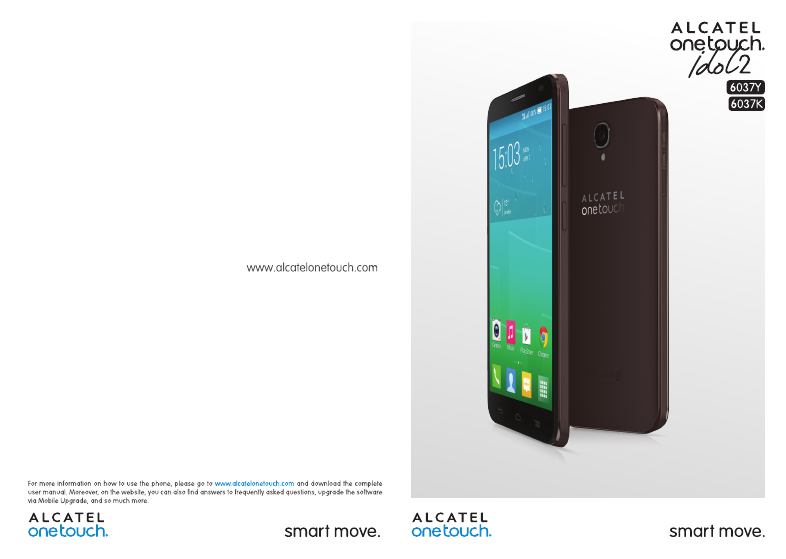
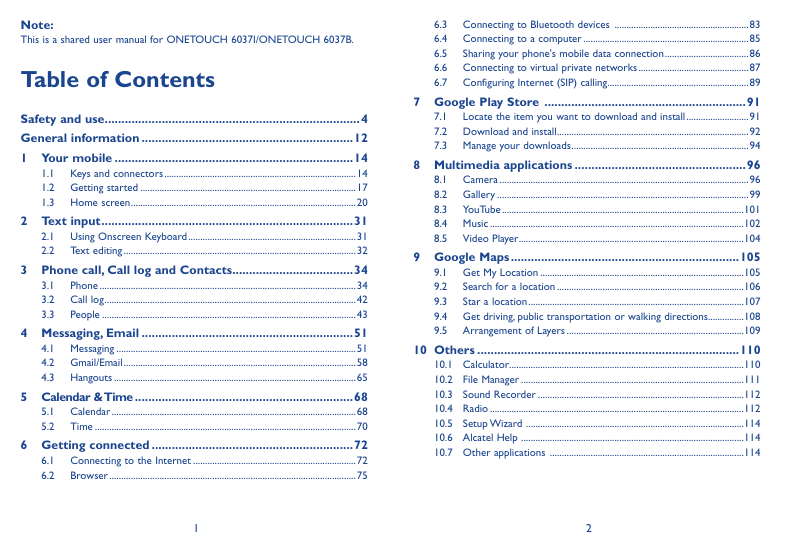
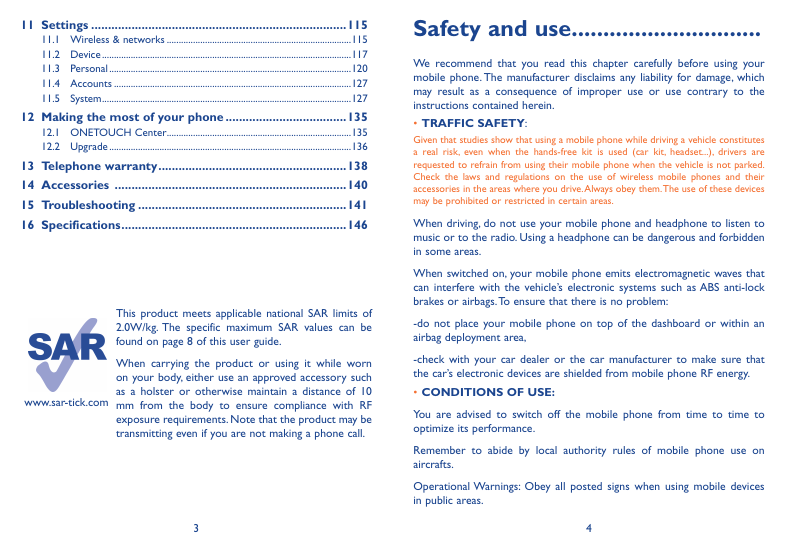

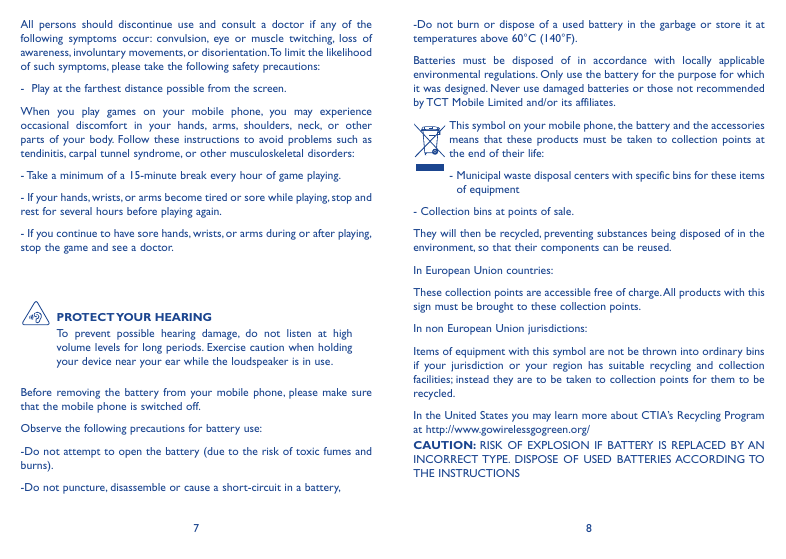
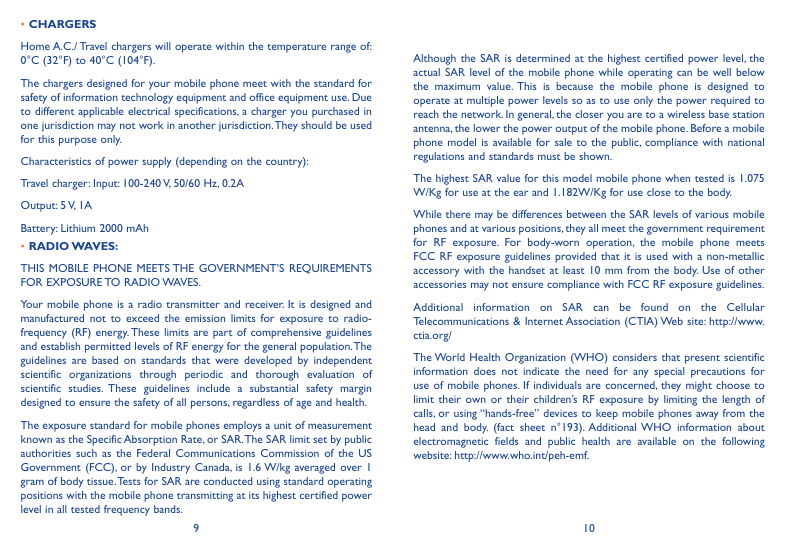
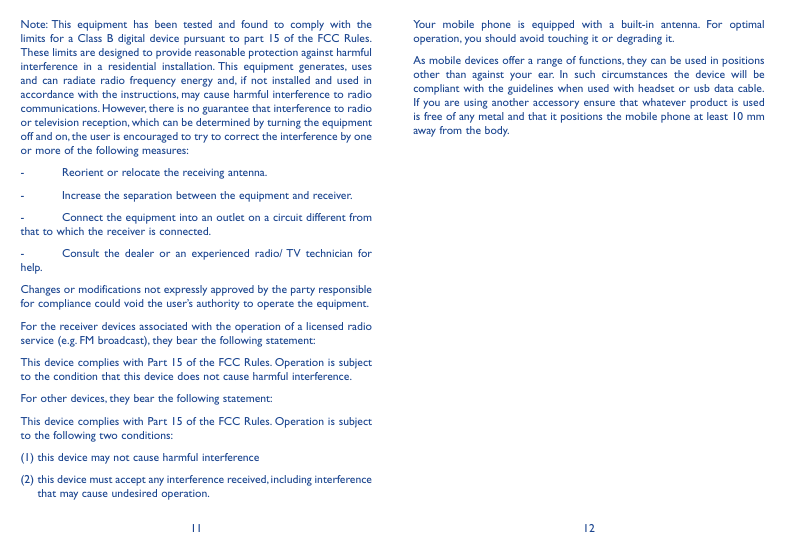
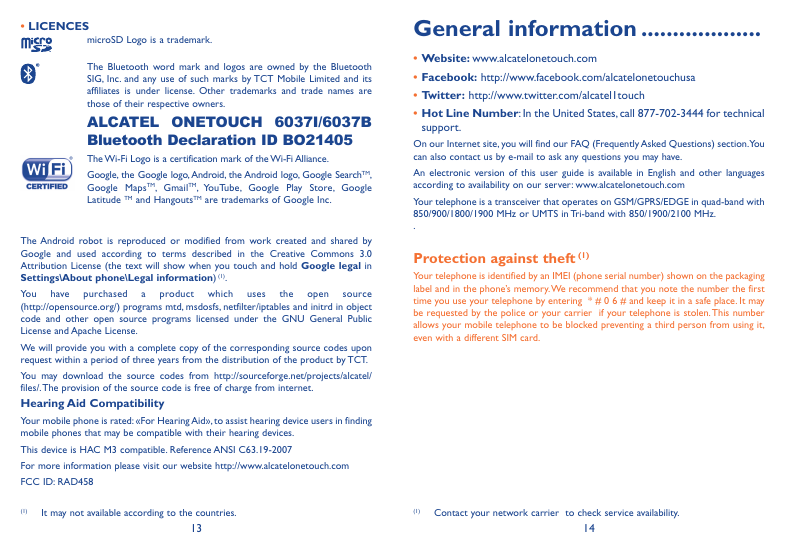








 2023年江西萍乡中考道德与法治真题及答案.doc
2023年江西萍乡中考道德与法治真题及答案.doc 2012年重庆南川中考生物真题及答案.doc
2012年重庆南川中考生物真题及答案.doc 2013年江西师范大学地理学综合及文艺理论基础考研真题.doc
2013年江西师范大学地理学综合及文艺理论基础考研真题.doc 2020年四川甘孜小升初语文真题及答案I卷.doc
2020年四川甘孜小升初语文真题及答案I卷.doc 2020年注册岩土工程师专业基础考试真题及答案.doc
2020年注册岩土工程师专业基础考试真题及答案.doc 2023-2024学年福建省厦门市九年级上学期数学月考试题及答案.doc
2023-2024学年福建省厦门市九年级上学期数学月考试题及答案.doc 2021-2022学年辽宁省沈阳市大东区九年级上学期语文期末试题及答案.doc
2021-2022学年辽宁省沈阳市大东区九年级上学期语文期末试题及答案.doc 2022-2023学年北京东城区初三第一学期物理期末试卷及答案.doc
2022-2023学年北京东城区初三第一学期物理期末试卷及答案.doc 2018上半年江西教师资格初中地理学科知识与教学能力真题及答案.doc
2018上半年江西教师资格初中地理学科知识与教学能力真题及答案.doc 2012年河北国家公务员申论考试真题及答案-省级.doc
2012年河北国家公务员申论考试真题及答案-省级.doc 2020-2021学年江苏省扬州市江都区邵樊片九年级上学期数学第一次质量检测试题及答案.doc
2020-2021学年江苏省扬州市江都区邵樊片九年级上学期数学第一次质量检测试题及答案.doc 2022下半年黑龙江教师资格证中学综合素质真题及答案.doc
2022下半年黑龙江教师资格证中学综合素质真题及答案.doc